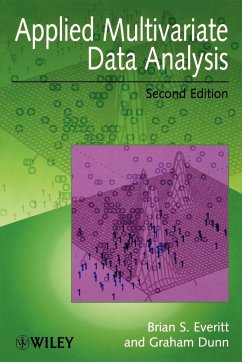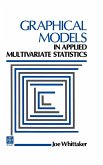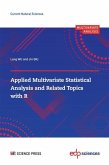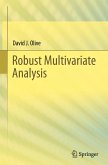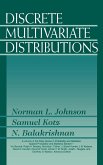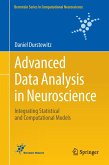- Broschiertes Buch
- Merkliste
- Auf die Merkliste
- Bewerten Bewerten
- Teilen
- Produkt teilen
- Produkterinnerung
- Produkterinnerung
Multivariate analysis plays an important role in the understanding of complex data sets requiring simultaneous examination of all variables. Breaking through the apparent disorder of the information, it provides the means for both describing and exploring data, aiming to extract the underlying patterns and structure. This intermediate-level textbook introduces the reader to the variety of methods by which multivariate statistical analysis may be undertaken. Now in its second edition, Applied Multivariate Data Analysis has been fully expanded and updated, including major chapter revisions as…mehr
Andere Kunden interessierten sich auch für
![Graphical Models in Applied Multivariate Statistics Graphical Models in Applied Multivariate Statistics]() J. WhittakerGraphical Models in Applied Multivariate Statistics376,99 €
J. WhittakerGraphical Models in Applied Multivariate Statistics376,99 €![Applied Multivariate Statistical Analysis and Related Topics with R Applied Multivariate Statistical Analysis and Related Topics with R]() Lang WUApplied Multivariate Statistical Analysis and Related Topics with R221,99 €
Lang WUApplied Multivariate Statistical Analysis and Related Topics with R221,99 €![Robust Multivariate Analysis Robust Multivariate Analysis]() David J. OliveRobust Multivariate Analysis61,99 €
David J. OliveRobust Multivariate Analysis61,99 €![Empirical Modeling and Data Analysis for Engineers and Applied Scientists Empirical Modeling and Data Analysis for Engineers and Applied Scientists]() Scott PardoEmpirical Modeling and Data Analysis for Engineers and Applied Scientists60,99 €
Scott PardoEmpirical Modeling and Data Analysis for Engineers and Applied Scientists60,99 €![Discrete Multivariate Distributions Discrete Multivariate Distributions]() Norman L JohnsonDiscrete Multivariate Distributions241,99 €
Norman L JohnsonDiscrete Multivariate Distributions241,99 €![Advanced Data Analysis in Neuroscience Advanced Data Analysis in Neuroscience]() Daniel DurstewitzAdvanced Data Analysis in Neuroscience49,99 €
Daniel DurstewitzAdvanced Data Analysis in Neuroscience49,99 €![Everything You Wanted to Know About Data Analysis and Fitting but Were Afraid to Ask Everything You Wanted to Know About Data Analysis and Fitting but Were Afraid to Ask]() Peter YoungEverything You Wanted to Know About Data Analysis and Fitting but Were Afraid to Ask38,99 €
Peter YoungEverything You Wanted to Know About Data Analysis and Fitting but Were Afraid to Ask38,99 €-
-
-
Multivariate analysis plays an important role in the understanding of complex data sets requiring simultaneous examination of all variables. Breaking through the apparent disorder of the information, it provides the means for both describing and exploring data, aiming to extract the underlying patterns and structure. This intermediate-level textbook introduces the reader to the variety of methods by which multivariate statistical analysis may be undertaken. Now in its second edition, Applied Multivariate Data Analysis has been fully expanded and updated, including major chapter revisions as well as new sections on neural networks and random effects models for longitudinal data. Maintaining the easy-going style of the first edition, this title provides clear explanations of each technique, supported by figures and examples, using minimal technical jargon. With extensive exercises following every chapter, the book is a valuable resource for students on applied statistics courses and for applied researchers in many disciplines.
Produktdetails
- Produktdetails
- Verlag: Wiley
- 2nd Revised edition
- Seitenzahl: 354
- Erscheinungstermin: 28. Juni 2010
- Englisch
- Abmessung: 234mm x 156mm x 19mm
- Gewicht: 538g
- ISBN-13: 9780470711170
- ISBN-10: 0470711175
- Artikelnr.: 30973239
- Herstellerkennzeichnung
- Libri GmbH
- Europaallee 1
- 36244 Bad Hersfeld
- gpsr@libri.de
- Verlag: Wiley
- 2nd Revised edition
- Seitenzahl: 354
- Erscheinungstermin: 28. Juni 2010
- Englisch
- Abmessung: 234mm x 156mm x 19mm
- Gewicht: 538g
- ISBN-13: 9780470711170
- ISBN-10: 0470711175
- Artikelnr.: 30973239
- Herstellerkennzeichnung
- Libri GmbH
- Europaallee 1
- 36244 Bad Hersfeld
- gpsr@libri.de
Brian S. Everitt is Professor of Behavioural Statistics and Head of the Biostatistics and Computing Department at the Institute of Psychiatry, King's College London, UK Graham Dunn is Professor of Biomedical Statistics and Head of the Biostatistics Group within the School of Epidemiology and Health Sciences, University of Manchester, UK
1 Multivariate data and multivariate statistics.
1.1 Introduction.
1.2 Types of data.
1.3 Basic multivariate statistics.
1.4 The aims of multivariate analysis.
2 Exploring multivariate data graphically.
2.1 Introduction.
2.2 The scatterplot.
2.3 The scatterplot matrix.
2.4 Enhancing the scatterplot.
2.5 Coplots and trellis graphics.
2.6 Checking distributional assumptions using probability plots.
2.7 Summary.
Exercises.
3 Principal components analysis.
3.1 Introduction.
3.2 Algebraic basics of principal components.
3.3 Rescaling principal components.
3.4 Calculating principal component scores.
3.5 Choosing the number of components.
3.6 Two simple examples of principal components analysis.
3.7 More complex examples of the application of principal components
analysis.
3.8 Using principal components analysis to select a subset of variables.
3.9 Using the last few principal components.
3.10 The biplot.
3.11 Geometrical interpretation of principal components analysis.
3.12 Projection pursuit.
3.13 Summary.
Exercises.
4 Correspondence analysis.
4.1 Introduction.
4.2 A simple example of correspondence analysis.
4.3 Correspondence analysis for two-dimensional contingency tables.
4.4 Three applications of correspondence analysis.
4.5 Multiple correspondence analysis.
4.6 Summary
Exercises.
5 Multidimensional scaling.
5.1 Introduction.
5.2 Proximity matrices and examples of multidimensional scaling.
5.4 Metric least-squares multidimensional scaling.
5.5 Non-metric multidimensional scaling.
5.6 Non-Euclidean metrics.
5.7 Three-way multidimensional scaling.
5.8 Inference in multidimensional scaling.
5.9 Summary.
Exercises.
6 Cluster analysis.
6.1 Introduction.
6.2 Agglomerative hierarchical clustering techniques.
6.3 Optimization methods.
6.4 Finite mixture models for cluster analysis.
6.5 Summary.
Exercises.
7 The generalized linear model.
7.1 Linear models.
7.2 Non-linear models.
7.3 Link functions and error distributions in the generalized linear model.
7.4 Summary.
Exercises.
8 Regression and the analysis of variance.
8.1 Introduction.
8.2 Least-squares estimation for regression and analysis of variance
models.
8.3 Direct and indirect effects.
8.4 Summary.
Exercises.
9 Log-linear and logistic models for categorical multivariate data.
9.1 Introduction.
9.2 Maximum likelihood estimation for log-linear and linear-logistic
models.
9.3 Transition models for repeated binary response measures.
9.4 Summary.
Exercises.
10 Models for multivariate response variables.
10.1 Introduction.
10.2 Repeated quantitative measures.
10.3 Multivariate tests.
10.4 Random effects models for longitudinal data.
10.5 Logistic models for multivariate binary responses.
10.6 Marginal models for repeated binary response measures.
10.7 Marginal modelling using generalized estimating equations.
10.8 Random effects models for multivariate repeated binary response
measures.
10.9 Summary.
Exercises.
11 Discrimination, classification and pattern recognition.
11.1 Introduction.
11.2 A simple example.
11.3 Some examples of allocation rules.
11.4 Fisher's linear discriminant function.
11.5 Assessing the performance of a discriminant function.
11.6 Quadratic discriminant functions.
11.7 More than two groups.
11.8 Logistic discrimination.
11.9 Selecting variables.
11.10 Other methods for deriving classification rules.
11.11 Pattern recognition and neural networks.
11.12 Summary.
Exercises.
12 Exploratory factor analysis.
12.1 Introduction.
12.2 The basic factor analysis model.
12.3 Estimating the parameters in the factor analysis model.
12.4 Rotation of factors.
12.5 Some examples of the application of factor analysis.
12.6 Estimating factor scores.
12.7 Factor analysis with categorical variables.
12.8 Factor analysis and principal components analysis compared.
12.9 Summary.
Exercises.
13 Confirmatory factor analysis and covariance structure models.
13.1 Introduction.
13.2 Path analysis and path diagrams.
13.3 Estimation of the parameters in structural equation models.
13.4 A simple covariance structure model and identification.
13.5 Assessing the fit of a model.
13.6 Some examples of fitting confirmatory factor analysis models.
13.7 Structural equation models.
13.8 Causal models and latent variables: myths and realities.
13.9 Summary.
Exercises.
Appendices.
A Software packages.
A.1 General-purpose packages.
A.2 More specialized packages.
B Missing values.
C Answers to selected exercises.
References.
Index.
1.1 Introduction.
1.2 Types of data.
1.3 Basic multivariate statistics.
1.4 The aims of multivariate analysis.
2 Exploring multivariate data graphically.
2.1 Introduction.
2.2 The scatterplot.
2.3 The scatterplot matrix.
2.4 Enhancing the scatterplot.
2.5 Coplots and trellis graphics.
2.6 Checking distributional assumptions using probability plots.
2.7 Summary.
Exercises.
3 Principal components analysis.
3.1 Introduction.
3.2 Algebraic basics of principal components.
3.3 Rescaling principal components.
3.4 Calculating principal component scores.
3.5 Choosing the number of components.
3.6 Two simple examples of principal components analysis.
3.7 More complex examples of the application of principal components
analysis.
3.8 Using principal components analysis to select a subset of variables.
3.9 Using the last few principal components.
3.10 The biplot.
3.11 Geometrical interpretation of principal components analysis.
3.12 Projection pursuit.
3.13 Summary.
Exercises.
4 Correspondence analysis.
4.1 Introduction.
4.2 A simple example of correspondence analysis.
4.3 Correspondence analysis for two-dimensional contingency tables.
4.4 Three applications of correspondence analysis.
4.5 Multiple correspondence analysis.
4.6 Summary
Exercises.
5 Multidimensional scaling.
5.1 Introduction.
5.2 Proximity matrices and examples of multidimensional scaling.
5.4 Metric least-squares multidimensional scaling.
5.5 Non-metric multidimensional scaling.
5.6 Non-Euclidean metrics.
5.7 Three-way multidimensional scaling.
5.8 Inference in multidimensional scaling.
5.9 Summary.
Exercises.
6 Cluster analysis.
6.1 Introduction.
6.2 Agglomerative hierarchical clustering techniques.
6.3 Optimization methods.
6.4 Finite mixture models for cluster analysis.
6.5 Summary.
Exercises.
7 The generalized linear model.
7.1 Linear models.
7.2 Non-linear models.
7.3 Link functions and error distributions in the generalized linear model.
7.4 Summary.
Exercises.
8 Regression and the analysis of variance.
8.1 Introduction.
8.2 Least-squares estimation for regression and analysis of variance
models.
8.3 Direct and indirect effects.
8.4 Summary.
Exercises.
9 Log-linear and logistic models for categorical multivariate data.
9.1 Introduction.
9.2 Maximum likelihood estimation for log-linear and linear-logistic
models.
9.3 Transition models for repeated binary response measures.
9.4 Summary.
Exercises.
10 Models for multivariate response variables.
10.1 Introduction.
10.2 Repeated quantitative measures.
10.3 Multivariate tests.
10.4 Random effects models for longitudinal data.
10.5 Logistic models for multivariate binary responses.
10.6 Marginal models for repeated binary response measures.
10.7 Marginal modelling using generalized estimating equations.
10.8 Random effects models for multivariate repeated binary response
measures.
10.9 Summary.
Exercises.
11 Discrimination, classification and pattern recognition.
11.1 Introduction.
11.2 A simple example.
11.3 Some examples of allocation rules.
11.4 Fisher's linear discriminant function.
11.5 Assessing the performance of a discriminant function.
11.6 Quadratic discriminant functions.
11.7 More than two groups.
11.8 Logistic discrimination.
11.9 Selecting variables.
11.10 Other methods for deriving classification rules.
11.11 Pattern recognition and neural networks.
11.12 Summary.
Exercises.
12 Exploratory factor analysis.
12.1 Introduction.
12.2 The basic factor analysis model.
12.3 Estimating the parameters in the factor analysis model.
12.4 Rotation of factors.
12.5 Some examples of the application of factor analysis.
12.6 Estimating factor scores.
12.7 Factor analysis with categorical variables.
12.8 Factor analysis and principal components analysis compared.
12.9 Summary.
Exercises.
13 Confirmatory factor analysis and covariance structure models.
13.1 Introduction.
13.2 Path analysis and path diagrams.
13.3 Estimation of the parameters in structural equation models.
13.4 A simple covariance structure model and identification.
13.5 Assessing the fit of a model.
13.6 Some examples of fitting confirmatory factor analysis models.
13.7 Structural equation models.
13.8 Causal models and latent variables: myths and realities.
13.9 Summary.
Exercises.
Appendices.
A Software packages.
A.1 General-purpose packages.
A.2 More specialized packages.
B Missing values.
C Answers to selected exercises.
References.
Index.
1 Multivariate data and multivariate statistics.
1.1 Introduction.
1.2 Types of data.
1.3 Basic multivariate statistics.
1.4 The aims of multivariate analysis.
2 Exploring multivariate data graphically.
2.1 Introduction.
2.2 The scatterplot.
2.3 The scatterplot matrix.
2.4 Enhancing the scatterplot.
2.5 Coplots and trellis graphics.
2.6 Checking distributional assumptions using probability plots.
2.7 Summary.
Exercises.
3 Principal components analysis.
3.1 Introduction.
3.2 Algebraic basics of principal components.
3.3 Rescaling principal components.
3.4 Calculating principal component scores.
3.5 Choosing the number of components.
3.6 Two simple examples of principal components analysis.
3.7 More complex examples of the application of principal components
analysis.
3.8 Using principal components analysis to select a subset of variables.
3.9 Using the last few principal components.
3.10 The biplot.
3.11 Geometrical interpretation of principal components analysis.
3.12 Projection pursuit.
3.13 Summary.
Exercises.
4 Correspondence analysis.
4.1 Introduction.
4.2 A simple example of correspondence analysis.
4.3 Correspondence analysis for two-dimensional contingency tables.
4.4 Three applications of correspondence analysis.
4.5 Multiple correspondence analysis.
4.6 Summary
Exercises.
5 Multidimensional scaling.
5.1 Introduction.
5.2 Proximity matrices and examples of multidimensional scaling.
5.4 Metric least-squares multidimensional scaling.
5.5 Non-metric multidimensional scaling.
5.6 Non-Euclidean metrics.
5.7 Three-way multidimensional scaling.
5.8 Inference in multidimensional scaling.
5.9 Summary.
Exercises.
6 Cluster analysis.
6.1 Introduction.
6.2 Agglomerative hierarchical clustering techniques.
6.3 Optimization methods.
6.4 Finite mixture models for cluster analysis.
6.5 Summary.
Exercises.
7 The generalized linear model.
7.1 Linear models.
7.2 Non-linear models.
7.3 Link functions and error distributions in the generalized linear model.
7.4 Summary.
Exercises.
8 Regression and the analysis of variance.
8.1 Introduction.
8.2 Least-squares estimation for regression and analysis of variance
models.
8.3 Direct and indirect effects.
8.4 Summary.
Exercises.
9 Log-linear and logistic models for categorical multivariate data.
9.1 Introduction.
9.2 Maximum likelihood estimation for log-linear and linear-logistic
models.
9.3 Transition models for repeated binary response measures.
9.4 Summary.
Exercises.
10 Models for multivariate response variables.
10.1 Introduction.
10.2 Repeated quantitative measures.
10.3 Multivariate tests.
10.4 Random effects models for longitudinal data.
10.5 Logistic models for multivariate binary responses.
10.6 Marginal models for repeated binary response measures.
10.7 Marginal modelling using generalized estimating equations.
10.8 Random effects models for multivariate repeated binary response
measures.
10.9 Summary.
Exercises.
11 Discrimination, classification and pattern recognition.
11.1 Introduction.
11.2 A simple example.
11.3 Some examples of allocation rules.
11.4 Fisher's linear discriminant function.
11.5 Assessing the performance of a discriminant function.
11.6 Quadratic discriminant functions.
11.7 More than two groups.
11.8 Logistic discrimination.
11.9 Selecting variables.
11.10 Other methods for deriving classification rules.
11.11 Pattern recognition and neural networks.
11.12 Summary.
Exercises.
12 Exploratory factor analysis.
12.1 Introduction.
12.2 The basic factor analysis model.
12.3 Estimating the parameters in the factor analysis model.
12.4 Rotation of factors.
12.5 Some examples of the application of factor analysis.
12.6 Estimating factor scores.
12.7 Factor analysis with categorical variables.
12.8 Factor analysis and principal components analysis compared.
12.9 Summary.
Exercises.
13 Confirmatory factor analysis and covariance structure models.
13.1 Introduction.
13.2 Path analysis and path diagrams.
13.3 Estimation of the parameters in structural equation models.
13.4 A simple covariance structure model and identification.
13.5 Assessing the fit of a model.
13.6 Some examples of fitting confirmatory factor analysis models.
13.7 Structural equation models.
13.8 Causal models and latent variables: myths and realities.
13.9 Summary.
Exercises.
Appendices.
A Software packages.
A.1 General-purpose packages.
A.2 More specialized packages.
B Missing values.
C Answers to selected exercises.
References.
Index.
1.1 Introduction.
1.2 Types of data.
1.3 Basic multivariate statistics.
1.4 The aims of multivariate analysis.
2 Exploring multivariate data graphically.
2.1 Introduction.
2.2 The scatterplot.
2.3 The scatterplot matrix.
2.4 Enhancing the scatterplot.
2.5 Coplots and trellis graphics.
2.6 Checking distributional assumptions using probability plots.
2.7 Summary.
Exercises.
3 Principal components analysis.
3.1 Introduction.
3.2 Algebraic basics of principal components.
3.3 Rescaling principal components.
3.4 Calculating principal component scores.
3.5 Choosing the number of components.
3.6 Two simple examples of principal components analysis.
3.7 More complex examples of the application of principal components
analysis.
3.8 Using principal components analysis to select a subset of variables.
3.9 Using the last few principal components.
3.10 The biplot.
3.11 Geometrical interpretation of principal components analysis.
3.12 Projection pursuit.
3.13 Summary.
Exercises.
4 Correspondence analysis.
4.1 Introduction.
4.2 A simple example of correspondence analysis.
4.3 Correspondence analysis for two-dimensional contingency tables.
4.4 Three applications of correspondence analysis.
4.5 Multiple correspondence analysis.
4.6 Summary
Exercises.
5 Multidimensional scaling.
5.1 Introduction.
5.2 Proximity matrices and examples of multidimensional scaling.
5.4 Metric least-squares multidimensional scaling.
5.5 Non-metric multidimensional scaling.
5.6 Non-Euclidean metrics.
5.7 Three-way multidimensional scaling.
5.8 Inference in multidimensional scaling.
5.9 Summary.
Exercises.
6 Cluster analysis.
6.1 Introduction.
6.2 Agglomerative hierarchical clustering techniques.
6.3 Optimization methods.
6.4 Finite mixture models for cluster analysis.
6.5 Summary.
Exercises.
7 The generalized linear model.
7.1 Linear models.
7.2 Non-linear models.
7.3 Link functions and error distributions in the generalized linear model.
7.4 Summary.
Exercises.
8 Regression and the analysis of variance.
8.1 Introduction.
8.2 Least-squares estimation for regression and analysis of variance
models.
8.3 Direct and indirect effects.
8.4 Summary.
Exercises.
9 Log-linear and logistic models for categorical multivariate data.
9.1 Introduction.
9.2 Maximum likelihood estimation for log-linear and linear-logistic
models.
9.3 Transition models for repeated binary response measures.
9.4 Summary.
Exercises.
10 Models for multivariate response variables.
10.1 Introduction.
10.2 Repeated quantitative measures.
10.3 Multivariate tests.
10.4 Random effects models for longitudinal data.
10.5 Logistic models for multivariate binary responses.
10.6 Marginal models for repeated binary response measures.
10.7 Marginal modelling using generalized estimating equations.
10.8 Random effects models for multivariate repeated binary response
measures.
10.9 Summary.
Exercises.
11 Discrimination, classification and pattern recognition.
11.1 Introduction.
11.2 A simple example.
11.3 Some examples of allocation rules.
11.4 Fisher's linear discriminant function.
11.5 Assessing the performance of a discriminant function.
11.6 Quadratic discriminant functions.
11.7 More than two groups.
11.8 Logistic discrimination.
11.9 Selecting variables.
11.10 Other methods for deriving classification rules.
11.11 Pattern recognition and neural networks.
11.12 Summary.
Exercises.
12 Exploratory factor analysis.
12.1 Introduction.
12.2 The basic factor analysis model.
12.3 Estimating the parameters in the factor analysis model.
12.4 Rotation of factors.
12.5 Some examples of the application of factor analysis.
12.6 Estimating factor scores.
12.7 Factor analysis with categorical variables.
12.8 Factor analysis and principal components analysis compared.
12.9 Summary.
Exercises.
13 Confirmatory factor analysis and covariance structure models.
13.1 Introduction.
13.2 Path analysis and path diagrams.
13.3 Estimation of the parameters in structural equation models.
13.4 A simple covariance structure model and identification.
13.5 Assessing the fit of a model.
13.6 Some examples of fitting confirmatory factor analysis models.
13.7 Structural equation models.
13.8 Causal models and latent variables: myths and realities.
13.9 Summary.
Exercises.
Appendices.
A Software packages.
A.1 General-purpose packages.
A.2 More specialized packages.
B Missing values.
C Answers to selected exercises.
References.
Index.

